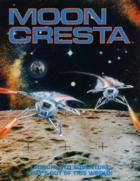- Moon Cresta
-
Moon Cresta
North American arcade flyer by Nihon Bussan (left) and US arcade flyer by Gremlin Industries (right). The illustration of Nichibutsu's Moon Cresta was also used for Moon Quaser's arcade flyer.Developer(s) Nichibutsu Publisher(s) Nichibutsu/Taito/SEGA Gremlin/Centuri Designer(s) Shigeki Fujiwara Platform(s) Arcade, ZX Spectrum, Commodore 64, BBC Micro, Amstrad CPC, Dragon 32, Sharp X68000, SNES, PS2, Virtual Console Release date(s) 1980 Genre(s) Shoot 'em up Mode(s) Two players alternating turns Cabinet Upright, Cocktail CPU Z80 (@ 3.072 MHz) Sound Tone generator and discrete circuits Display Raster, 224 x 256 pixels (Vertical), 98 colors Moon Cresta (ムーンクレスタ) is an arcade game released in 1980 by Nichibutsu. Incentive Software published a version of this arcade game for many 8-bit home computers of the time. Dempa also released a port of both Moon Cresta and Terra Cresta for the X68000. It was also released on the Wii Virtual Console in Japan on March 9, 2010.
Contents
Gameplay
Moon Cresta is a two-dimensional, single screen shoot-em-up in the same mould as Taito's Space Invaders and Namco's Galaxian. The player begins the game with a small spaceship armed with a single laser cannon. After successfully completing the first four waves of alien attacks, the player must attempt to dock his ship with the next 'stage' of the ship. This second stage has two lasers in addition to the original one. (Each docked stage is one of the player's "lives." This concept of docking two "lives" together to increase firepower would later reappear in Galaga.)
After successfully clearing two more waves of aliens, the player must again dock with the third and final piece of the ship which also has two more lasers (giving the player 5 lasers in total). The trade-off for this is that the entire ship is a much larger target. Failure to correctly align the stages during either docking sequence causes the destruction of the stage being docked with.
After completing the first eight waves the player's ship reverts to the first stage and the process is repeated. If any of the player's three ships are lost along the way, the docking sequence occurs only after the first four waves have been completed.
Play ends when all three of the player's ship-stages are destroyed. If the player reaches a score of 30,000 points, he is awarded an extra stack of 3 more ship-stages.
Critical reception
The ZX Spectrum conversion, published in 1985 by Incentive Software, was met with average review scores. Your Spectrum awarded two hits out of three: the gameplay was felt to be close to the arcade original, but was showing its age.[1] Sinclair User awarded 3 out of 5 stars, and considered it only worth playing in order to win Incentive's prize for the first person to reach 30,000 points.[2]
Variations
The most difficult version of Moon Cresta is the Nichibutsu version since in this version in the D4 Eagle waves, the last D4 Eagle becomes invisible.
The following details the main variation differences:
Taito Moon Cresta
Wave 1+2 Aliens hover until several are shot.
Wave 5+6 D4 Eagle Aliens are never invisble.
Wave 9+10 Spears start with 1 flying downwards on first round and increase by 1 each round i.e. second time round there are 2 etc until all 10 fly down at once.
Aliens slow down in waves 1-4 if player killed.
Free game at 30000.
Spears fly faster at end of wave 4 plus from then on last alien flies faster i.e. round 5.
Similar to Taito is Fantazia with different Sprite colours.Sega/Gremlin Moon Cresta
Wave 1+2 Aliens do not hover.
Aliens speed up on 3rd round.
2 spears drop on first round.
No invisible D4 eagles.
Aliens do not slow down in waves 1-4 if player killed.
Free game 30000.Centuri Eagle Moon Cresta Clone
Different sprites used throughout but essentially the same as Taito version except aliens speed up on 6th round.
Nichibutsu Moon Cresta
As Gremlin plus: Last alien on waves 1-4 moves differently
Last D4 Eagle is invisibleSuper Moon Cresta
Same as Taito revision only aliens fire 1 bullet plus player ships shoot faster.
Legacy
- Moon Cresta (1980)
- Terra Cresta (1985)
- Dangar - Ufo Robo (1986)
- Terra Force (1987)
- Terra Cresta II (1992, PC Engine)
- Terra Cresta 3D (1997, Sega Saturn)
Moon Cresta in Popular Culture
A Moon Cresta machine can be seen and heard in the background of the Boardwalk Comics Shop in the 1987 film The Lost Boys.
High Scores
Bill Awalin holds the high score for the Sega/Gremlin version with 152,100 points (29/02/1984).
Marcus McHaffie holds the high score for the Nichibutsu version submitted via M.A.M.E with 153,490 points (17/08/2011).External links
- Moon Cresta at Coinop.org
- Moon Cresta at the Killer List of Videogames
- Twin Galaxies International Official Scorekeepers
References

This fixed shooter article is a stub. You can help Wikipedia by expanding it.


